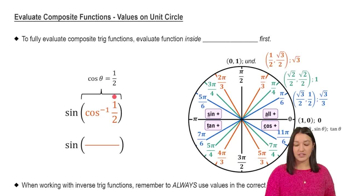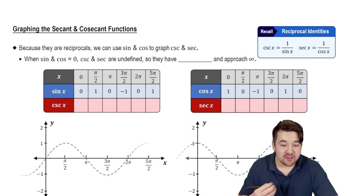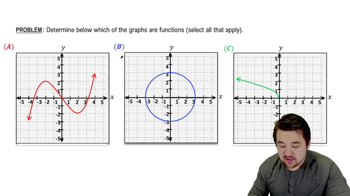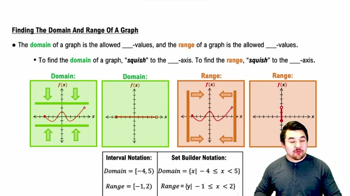Table of contents
- 0. Functions7h 52m
- Introduction to Functions16m
- Piecewise Functions10m
- Properties of Functions9m
- Common Functions1h 8m
- Transformations5m
- Combining Functions27m
- Exponent rules32m
- Exponential Functions28m
- Logarithmic Functions24m
- Properties of Logarithms34m
- Exponential & Logarithmic Equations35m
- Introduction to Trigonometric Functions38m
- Graphs of Trigonometric Functions44m
- Trigonometric Identities47m
- Inverse Trigonometric Functions48m
- 1. Limits and Continuity2h 2m
- 2. Intro to Derivatives1h 33m
- 3. Techniques of Differentiation3h 18m
- 4. Applications of Derivatives2h 38m
- 5. Graphical Applications of Derivatives6h 2m
- 6. Derivatives of Inverse, Exponential, & Logarithmic Functions2h 37m
- 7. Antiderivatives & Indefinite Integrals1h 26m
- 8. Definite Integrals4h 44m
- 9. Graphical Applications of Integrals2h 27m
- 10. Physics Applications of Integrals 2h 22m
0. Functions
Introduction to Functions
Problem 1
Textbook Question
Functions and Graphs
Express the area and circumference of a circle as functions of the circle’s radius. Then express the area as a function of the circumference.
 Verified step by step guidance
Verified step by step guidance1
Start by recalling the formulas for the area and circumference of a circle. The area \( A \) of a circle is given by \( A = \pi r^2 \), where \( r \) is the radius. The circumference \( C \) is given by \( C = 2\pi r \).
Express the area \( A \) as a function of the radius \( r \). This is already given by the formula \( A(r) = \pi r^2 \).
Express the circumference \( C \) as a function of the radius \( r \). This is given by the formula \( C(r) = 2\pi r \).
To express the area as a function of the circumference, first solve the circumference formula for \( r \). From \( C = 2\pi r \), we get \( r = \frac{C}{2\pi} \).
Substitute \( r = \frac{C}{2\pi} \) into the area formula \( A = \pi r^2 \) to express the area as a function of the circumference: \( A(C) = \pi \left(\frac{C}{2\pi}\right)^2 \). Simplify this expression to complete the function.
 Verified video answer for a similar problem:
Verified video answer for a similar problem:This video solution was recommended by our tutors as helpful for the problem above
Video duration:
1mPlay a video:
Was this helpful?
Key Concepts
Here are the essential concepts you must grasp in order to answer the question correctly.
Area of a Circle
The area of a circle is calculated using the formula A = πr², where A represents the area and r is the radius. This formula shows that the area is directly proportional to the square of the radius, meaning that as the radius increases, the area increases quadratically.
Recommended video:

Estimating the Area Under a Curve with Right Endpoints & Midpoint
Circumference of a Circle
The circumference of a circle is given by the formula C = 2πr, where C is the circumference and r is the radius. This formula indicates that the circumference is directly proportional to the radius, meaning that if the radius doubles, the circumference also doubles.
Recommended video:

Evaluate Composite Functions - Values on Unit Circle
Function Relationships
In this context, expressing the area as a function of the circumference involves manipulating the formulas for area and circumference. By substituting the expression for radius from the circumference formula into the area formula, we can derive a new function A(C) that relates area directly to circumference.
Recommended video:

Graphs of Secant and Cosecant Functions

 1:36m
1:36mWatch next
Master Introduction to Calculus Channel with a bite sized video explanation from Callie
Start learning





